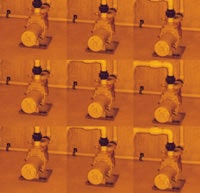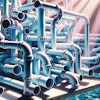
When we last wrote about lowspeed pumping, it was a story about early adopters and onerous regulation. Just a year later, it's a story of how an entire industry has come to view pool water circulation from a completely different vantage point.
Lowering system resistance by running the pump at low speed is now commonly understood as an important goal in pumping applications, and just a few years ago, it wasn't. That is real progress.
There have always been people in the pool industry who knew that lowered flow rates would provide exponential energy savings. The physics of the question have remained unaltered since the beginning of time - half the pump speed requires only 12.5 percent of the energy. (These are values obtained from the Affinity Law of fluid dynamics, which does not account for losses in the system.) Still, for decades, the high-horsepower pumps churned. And all over the world, tiny hands on a million kilowatt meter dials spun.
It wasn't until recently that the idea took hold as a growing awareness among builders and service personnel of "the power of low power." It was the advent of variable-speed pumps, and dual- and multi-speed pumps - spurred by legislative action - that sparked the enlightenment. These allow a pool owner to run at high speed when necessary, but to rely on low-flow, low-speed pumping for routine filtration and mixing. The savings for the consumer is astronomical - a thousand dollars a year on some pools. The energy conservation implications are equally as great.
And the full payoff is yet to come, according to Steve Gutai, pool products manager, Jandy, Petaluma, Calif. "The emergence of low-flow pumping is good, but the full benefits of it have yet to be realized and won't be realized until system components are redesigned to work properly with it." Most system components on the market now were created in the days when people blasted their pools at high flow rates for six hours a day instead of low flow rates for 16. "Many of these components do not work well with low-flow, low-pressure pumping," Gutai adds. "Everything from skimmer weirs to in-floor cleaning systems will have to be redesigned."
They're working on it. Major pump manufacturers are introducing integrated systems that reduce head all down the line and help take full advantage of the energy saving capabilities of variable-speed pumps.
Pentair's Eco Select line, as one example, features oversize filters and valves to circumvent flow around the heater when it is not heating, thereby reducing resistance in the line. The system not only saves copious amounts of power (and money for the homeowner), but reduces water consumption and noise pollution, as well. In addition, its components work better and last longer due to less stress.
Somehow, through a combination of product innovation, regulation and education, the many benefits of reducing total dynamic head are now common currency in discussions of pool equipment. It's nothing short of a revolution, although based on oldschool fluid dynamics.
It will take time before this new pool equipment paradigm is completely fleshed out - hidden benefits pop up everywhere you look. Even sanitization can be improved with longer, slower turnover times, notes Scott Clay, program manager for pools at Pacific Gas and Electric Co., a California utility based in San Francisco.
"Look at the chemistry of a pool," he says. "A pool doesn't like stagnant water. But if you look at what people have done in the past to try to reduce the electrical cost of operating a pool, they've pumped really fast for four hours and shut her down.
"So for 20 hours a day there was stagnant water. And that doesn't do anything for sanitization. Where you really do sanitization is on the filter itself. As you're pulling water through the filter, you get the highest concentration of the sanitizer on the filter medium. So you get better filtration and better sanitation if you keep the water flowing."
Dawning
So how did this all come about? The industry-education effort started many years ago, but it seemed to get little traction until 2006, when the California Energy Commission led a growing list of state legislative bodies mandating improvement in pool pump efficiency.
Like most governmental bodies, the CEC knew what it wanted, but didn't exactly know how to get it. In the absence of hard data on specific pool pumps and motors, notes Clay, the CEC simply looked at the types of technology typically used on less-efficient motors and abolished them. While this was of limited value and impact, it got people's attention. It's safe to say this first round of regulation was not greeted warmly by the pool industry. There's not much enthusiasm for government mandates in any indus t r y, and many fel t the new edi c t s were unnecessary, and in particular had not been well communicated in advance.
"It's a big market for pools," notes Clay, "and the manufacturers really didn't like California trying to drive their business."
In a letter to the executive director of the CEC, Don Burns, president and CEO of SPEC, the California lobbying group, stated, "We strongly believe that if the regulations go into effect…they will have a significantly negative impact on the quality and safety of swimming pools and spas installed in the state."
Strong beliefs notwithstanding, the regulations became law and the industry was informed that a new set of regs would soon follow in 2008. These stipulated that all pool filtration pumps 1-horsepower or greater (which is most of them) have two or more speeds.
This was critical. With manufacturers stepping up development of lowspeed- capable options, and intensive training and consumer incentive programs going full steam, the real possibilities of low-flow pumping emerged to a wider audience. Industry seminars, magazine articles and manufacturer education efforts focused on the issue. At PG&E, Clay hit the road with a demonstration trailer in tow, headed for industry gatherings. His setup had different pumps wired to meters that could display power usage for a given flow. "You want 60 gpm for six hours a day," says Clay, "here's the energy usage.
"What we found was that people knew that TDH [total dynamic head, or system resistance] went up with increased flow - they did acknowledge that - but their answer was a bigger pump. What they didn't realize was that the amount of power usage goes up exponentially with that bigger pump.
"That was one of the biggest arguments we got about two-speed pumps. Guys said that at half speed you'd use half the power, and if you take twice as long to turn over the pool, then you haven't saved a thing.
"They didn't realize that at half the speed you use one-eighth the power. "But when they saw that you could take a two-speed pump and pump 30 gpm for 12 hours a day at one-fourth the cost, then it started making sense to them."
It was a huge educational effort, still ongoing today, to help the service professionals, builders and even consumers understand that an enormous improvement in efficiency comes when you slow the flow. Jeff Farlow, program manager for energy initiatives, Pentair Water Pool and Spa, Sanford, N.C., has been in the thick of it.
The company has been working with utilities to help service personnel and builders sell energy efficiency. It has six demonstration trailers spread across the country and has graduated more than 1,300 industry professionals from its traditional classroom training seminars. The financial incentive has played a decisive role, he points out.
"A powerful force behind the movement," Farlow says, "is a pool professional being able to go into a homeowner's backyard and say, 'This is costing you $5 a day to operate. I can bring that down to 75 cents.' "And it's given service guys the opportunity to sell a big-ticket item. Usually they're called in when a piece of equipment fails, but now they've got an opportunity to create a highdollar sale.
"They're convincing homeowners to take a perfectly functional pump and throw it away. Because it can pay for itself - sometimes within a year. And then keep paying off. And because it performs so much better, and the customer saves so much money, it's a win for them, too." It's tough to determine when the t ipping point came. "There's a moment when you are working to explain an idea," Clay says, "when the tension is suddenly replaced by understanding." He believes it was early 2007 when "all the lights went on, everybody star ted jumping onboard, and all of a sudden there was a great awareness throughout the industry that this was here to stay."
Besides energy savings, Clay recalls, builders began to see secondary benefits from low-speed pumping - equipment lasts longer, filtration is better and easier to service, there is less channeling in filters, less dead time in the pool when algae can grow. "That's when the industry turned the corner, if you will."
The commitment from the manufacturers was crucial, he adds. "The other thing that happened at that time was that Pentair got into production with their variable-speed pump, so now with Ikeric there were two on the market, and Hayward was next to jump onboard with a variable-speed pump, and Jandy was right behind."
Priming A New Pump
Once they entered the variable-speed market, these manufacturers found to their surprise that the new pumps could be the headwaters of an entirely new revenue stream - energy-efficient pool systems. It was something of a revelation to many who believed the old industry paradigm that energy, as a cost burden to the prospective buyer, was a taboo subject.
Once it was plain that a large portion of the pool market was very interested in reducing energy consumption and cost, and would pay handsomely for it, manufacturers jumped in with both feet. Says Clay, "The change in the industry in a short period of time has been amazing. It may have been regulation that required the change, but the response of the major manufacturers of pool pumps has really been impressive.
"Think of a boat capsizing. It will lean for a long time, and all of a sudden it just flops over. That's exactly what's happened in this industry. It flopped over in 2007."
A fortunate combination of factors paved the way. The impetus for change came from California because of the state's high energy costs. But the enormous size of its pool market formed the critical mass necessary for change nationwide.
Nevertheless, while there's no going back to single-speed, highhorsepower pumps (except on some dedicated circuits), a great deal of work lies ahead for an equipment industry in transition. "At the moment," says Gutai, "there are still a limited number of applications that work with the pump in a low-flow, low-pressure mode."
And as Farlow points out, the people who design new pools have the most impact. The key is to win them over en masse. "Once the pool is built and you're looking at retrofit," he says, "there are limitations." That means, essentially, that builder education has never been more important. But the possibilities of lowflow pumping make a great incentive. "When you stop and look at the benefits of slowing the flow in pool pumping applications," says Farlow, "it's hard to ignore. It really is."








































